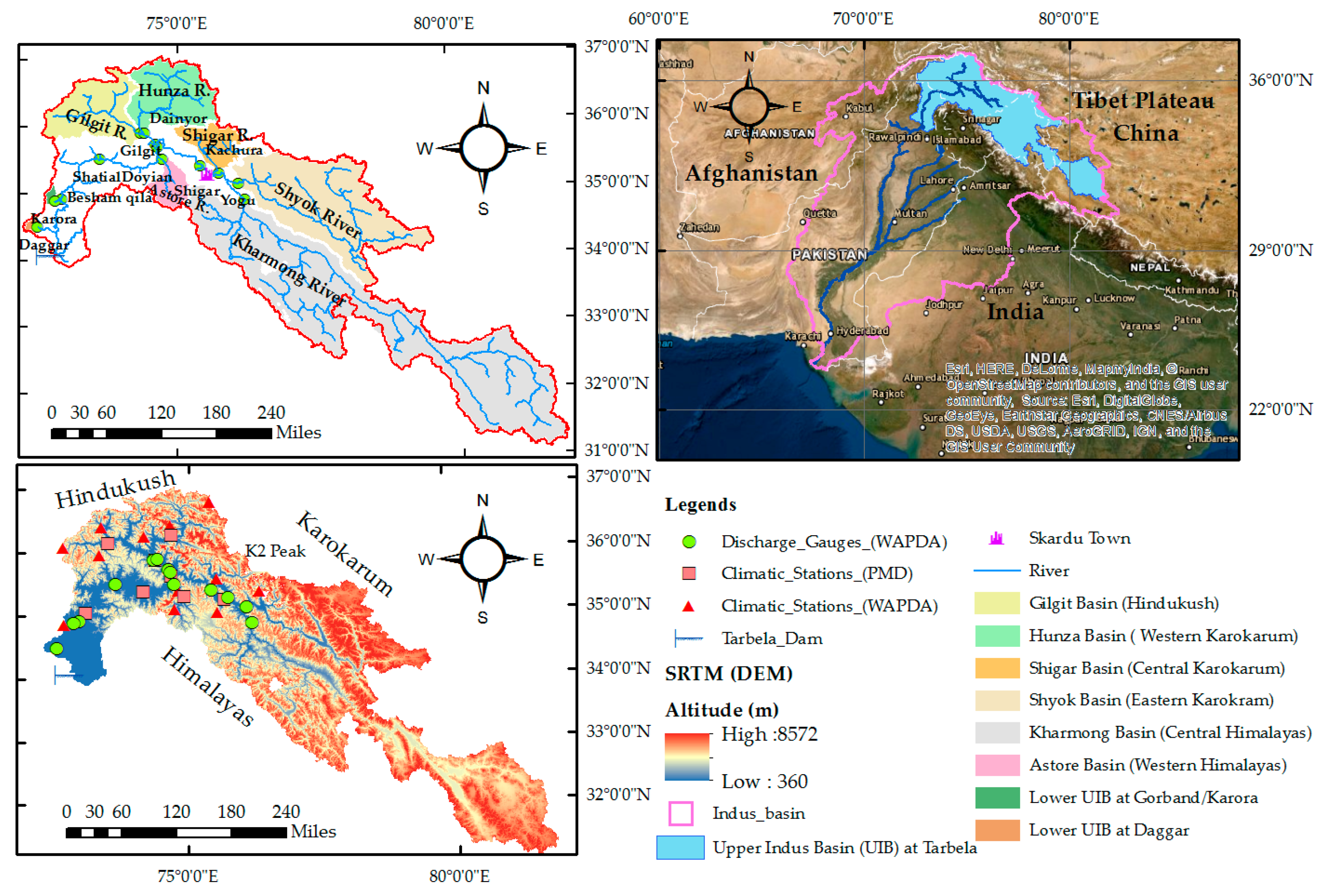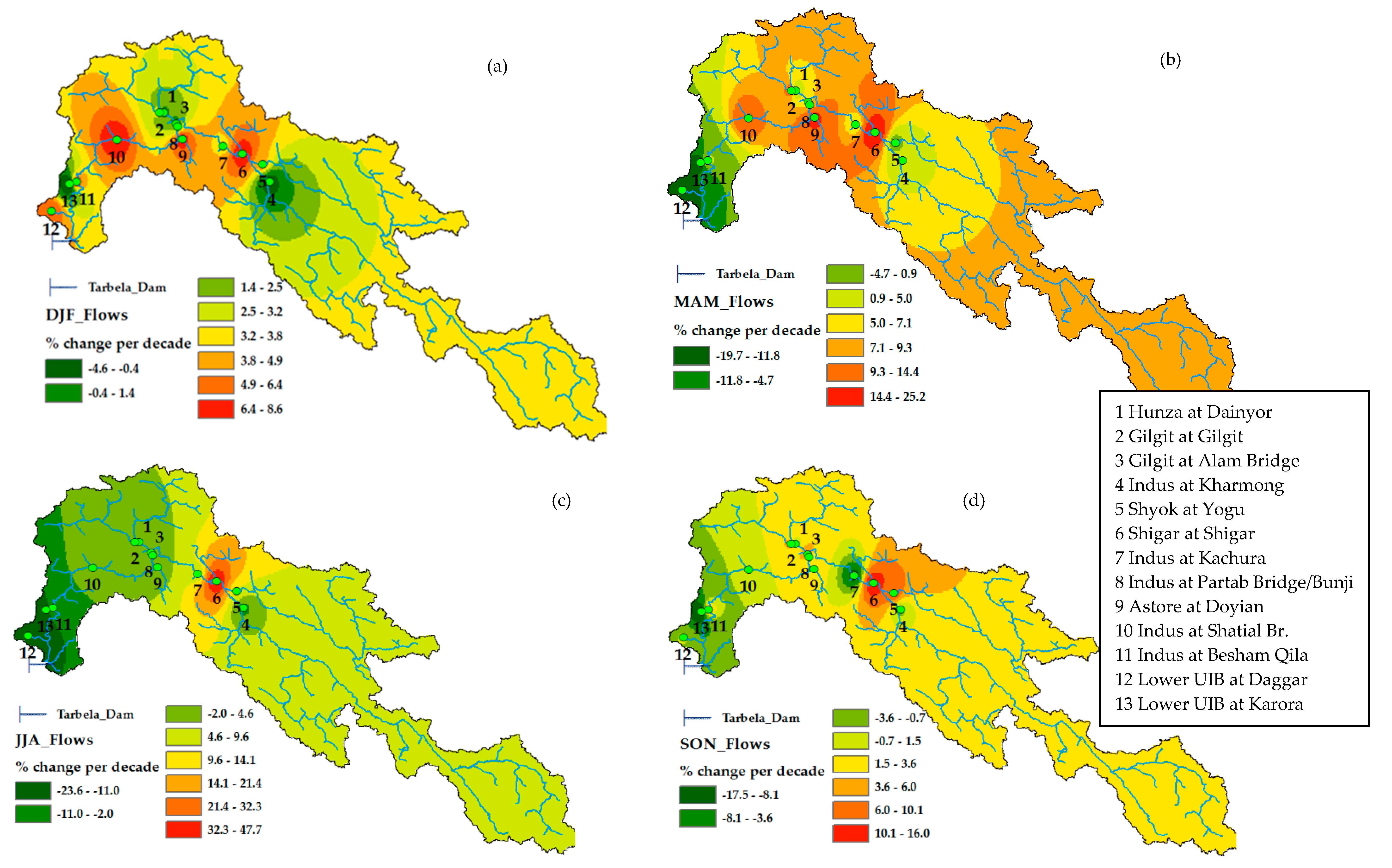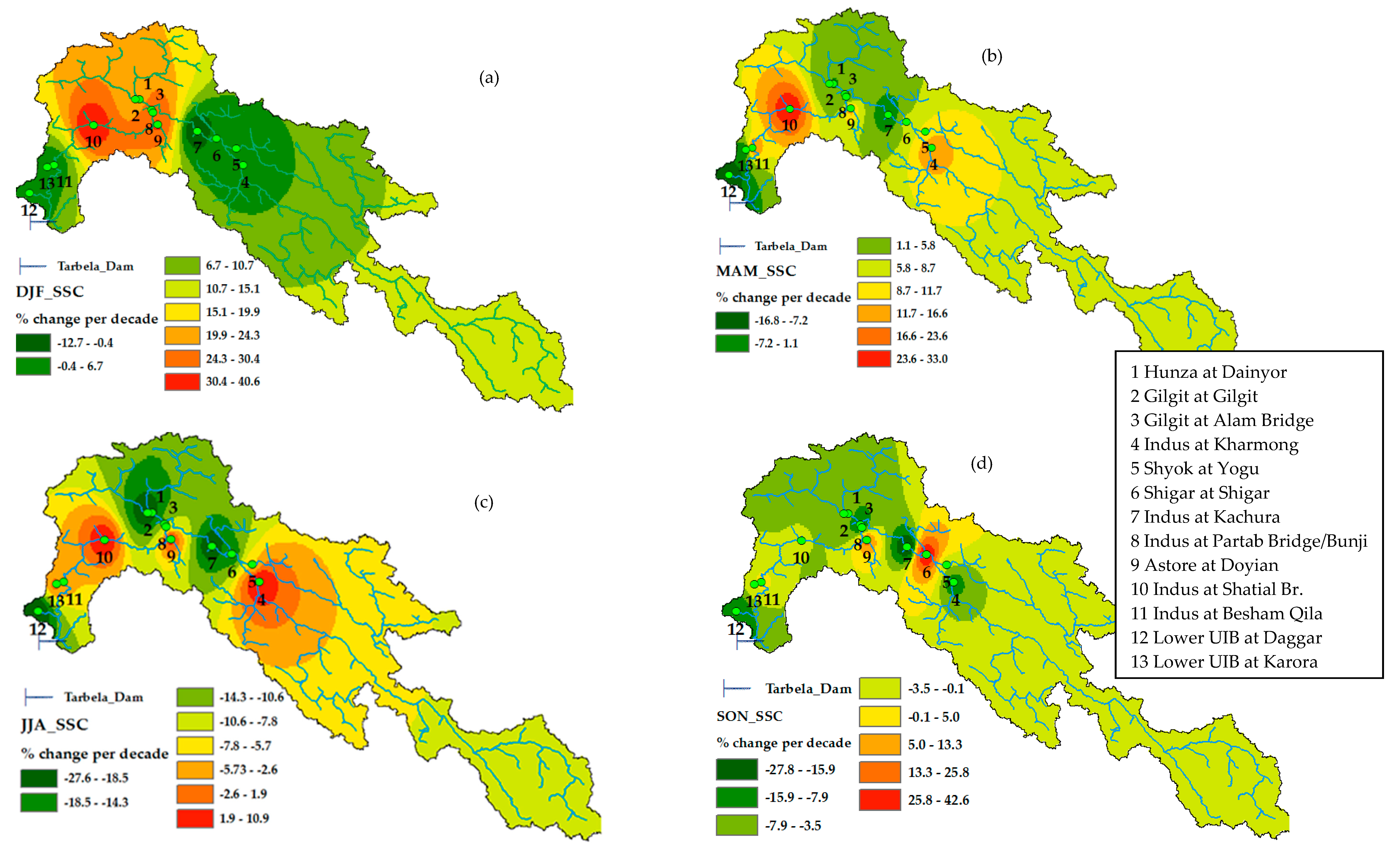2.1. Study Area
The Indus River is among the largest rivers in South Asia with its total length of 2880 km [
24,
25]. It has a total catchment area of 970,468 km
2 with about 56% (529,134 km
2) of its area lying within the territory of Pakistan. The remaining catchment area is distributed between China, India, and Afghanistan. It also has the world’s largest irrigation networks covering an irrigated agricultural area of 181,000 km
2 [
26,
27]. Moreover, the Indus basin is an economic source of energy. Hydropower produced here has a share of 29% in the total national power generation capacity of Pakistan [
27].
This study focuses on the Upper Indus Basin (UIB) upstream of the Tarbela dam with a total catchment area of 172,000 km
2 and a length of 1125 km [
18,
28]. The watershed area of the UIB upstream of the Tarbela reservoir is situated at 31°–37° E and 72°–82° N. The watershed elevation of the UIB above the Tarbela dam ranges from 360 to 8572 m above mean sea level [
28]. The detailed characteristics of the gauging stations measuring flows and SSC at 13 locations in the UIB are given in the
Table 1. Four gauging stations are located on the main arm of the Upper Indus, eight on the tributaries, and one station, Alam Bridge, at the confluence of two tributaries.
Figure 1 shows the details of the catchment area, the sub-basins, and the tributaries of the UIB. It starts from the frozen planes of the Tibetan Plateau in China. Then, it enters from the south eastern direction in a well-defined valley and flows parallel to the geological fault line. After crossing the fluvial plains 45 km upstream of Skardu town at an altitude of 2469 m, it joins Shyok River with 30% of glacier drainage area. Here, the valley widens and mostly consists of sediments in the form of glacial deposits down to Skardu town. Upstream of Skardu in the Deosai plains, the Kharmong River from the central Himalayas lying in Pakistan joins the main (Indus) River with a total glacier-covered area of 4%. Kharmong River is dominated by a snow and rainfall flow regime.
Near the town of Skardu, the Shigar River with 39% of glacier-covered area from the Himalayas drains into the main (Indus) River at an altitude of 2438 m. Downstream of Skardu town, the main River flows towards the Northwest up to Kachura Lake along the steep and narrow valley of the main River. The Hunza River runs from North to South and Gilgit River runs from the Northwest to Southeast before confluence at Alam Bridge just downstream of Gilgit town. Hunza Basin borders with Shigar Basin on the right side in the direction of flow. Hunza and Gilgit Rivers are snow- and glacier-dominated basins lying in the Western Karakorum and Hindukush mountain ranges with 39% and 10% of glacier-covered area, respectively. Astore River also joins the main River. It comes from the western Himalayas with 8% of glacier-covered area north of the Nanga Parbat massif. Downstream of Alam Bridge, the confluence of Gilgit and Hunza Rivers join the main Indus River at Bunji/Partab Bridge in Jaglot town. Jaglot is a monumental place, where all three great mountain ranges, the Himalayas, Karakorum, and Hindukush, meet. The lower part of the UIB starts at Bunji and extends up to Tarbela dam. The main river widens between Alam Bridge and Chillas and contains sediments in the form of glacier deposits. The Indus River continues its journey towards Shatial Bridge. From Shatial Bridge, the main river flows further towards the South in a steep and narrow cross section and joins Besham Qila, approx. 45 km upstream of the Tarbela reservoir. Near Besham Qila, some small and large rivers also join the Indus from both the left and the right side. The right tributaries joining the main Indus River near Besham Qila are Brandu, Gorband, Khan Khawar, Duber Khwar, Keyal Khwar, Kandia, and Tangir. The left tributaries joining the main Indus River near Besham Qila are Siran, Chor Nullah, Spat Gah, Allai Khwar, Gunar Gah, Thor Gah, and Butto Gah.
The climate of the UIB comprises two climatic fronts. One is the monsoon pattern of rainfall that originates from the Bay of Bengal and Arabian Sea. The second is the westerlies climatic front originating from the Caspian Sea and Mediterranean region during winters and springs. Most of the annual precipitation in the UIB falls in the form of snow during the winter and spring season due to westerlies [
29,
30]. Mean annual precipitation in Gilgit ranges from 150 mm at lower elevations to 1800 mm in the snow accumulation zone in Bagrot valley [
31]. In the Western Karakorum over the Batura glaciers, annual precipitation accounts for more than 1000 mm [
32]. In the Central Karakorum, annual precipitation ranges from 1000 mm to more than 2000 mm over the Hispar and Biafo glaciers [
33]. In the Central Karakorum, 67% of annual precipitation fall during winter is due to the westerly front, with the remaining 33% of annual rainfall during the summer season [
7,
34,
35]. In the lower UIB, annual rainfall ranges from 1000 mm to 1500 mm between Dasu and Besham Qila [
23]. In the UIB, the maximum mean basin rainfall occurs during the spring season, with April being the month of highest rainfall [
36].
In the UIB the upper glaciered has very low population density (<50 people km
2) in comparison to the lower monsoon dominated region. The upper region of UIB has an estimated population of 1.5 Million. The lower region of UIB is vice versa. The upper region of UIB also has high percent of snow/ice cover, at up to 40% in Hunza, Gilgit, Shigar, and Shyok river basins. This snow/ice cover emerges as a single dominated land cover factor which explains 73.4% of the variance in sediment yields for whole UIB [
37].
The trends induced by climate change on the discharges of various sub-catchments have been widely reported by many researchers [
7,
8,
38,
39], however, scientific literature on the spatio-temporal variation of SSC is far less extensive. Ali and De Boer [
18] analyzed the spatial distribution of sediment in the UIB by dividing the region into three zones: upper snow- and glacial melt-dominated zone, middle snow-/glacial melt-, and rainfall-dominated mixed zone, and lower rainfall-dominated zone. Ateeq-Ur-Rehman et al. and Tarar et al. [
22,
23] identified the trends of SSC by using the data of two and four gauging stations of the UIB, respectively. Meanwhile, the former used the SSC of Hunza basin at Danyor, Shyok basin at Yogu, Upper Indus at Bunji/Partab Bridge, and Upper Indus at Besham Qila. They have used data from the gauge of Partab Bridge for the melt portion of the UIB and from Besham Qila to represent the load of the entire UIB. These studies found a significant inter-annual shift of SSC with the balanced annual sediment yield. However, an assessment of the spatio-temporal variation of SSC and discharges in relation to relevant hydrometeorological parameters and variables for all the sub-basins of the entire UIB has not yet been made. This study therefore covers the trends of spatial variability of SSC and discharges in the UIB using the data of 13 gauging stations located in the Karakorum, Himalayan, and Hindukush regions that represent almost the entire UIB with its eight sub-catchments (
Table 1). Moreover, the previous studies used daily sediment values derived from discharge-sediment rating curves (SRC) and artificial neural networks (ANN) [
22,
23]. The SRC and databased models give highly overestimated and underestimated values and sometimes negative values, which are physically not possible. Especially, for the highly glacier and snow melt basins, the SRC are not reliable. In comparison to previous researches in the region that mainly relied on discharge-sediment rating curves (SRC) and artificial neural networks (ANN) for SSC, the mean of monthly sediments was taken by averaging the daily SSC gauged data. Thereby, SRC values were only used in those months where no information of sediment concentrations was available. This study is also one of the pioneer researches that used corrected estimates of rainfall and temperature for the assessment of comparative trends of precipitation, temperature, and SSC in the UIB [
40,
41].
2.2. Data Collection
For the present study, the data of 13 stream gauges in the UIB for the period 1981–2010 were collected within the Surface Water Hydrology Project (SWHP) of the Water and Power Development Authority (WAPDA). These stations measure flows on a daily basis and SSC on intermittent days. A rating curve was used to find the missing values of SSC for monthly, seasonal, and annual trend analysis. The list and characteristics of these stations are given in
Table 2.
Hunza is second largest glacier-dominated basin of the UIB in the Western Karakorum. Here, data are available for the period of 1981–2010. The Hunza River generates 12% and 12.5% of the Besham Qila flows and suspended sediment loads (SSL), respectively. The Gilgit station at Gilgit lies in the Hindukush mountain range draining the Gilgit river basin. Here, data are available for 1981–2010. Its flows and SSL are 12% and 3.9% of the Besham Qila flows and SSL, respectively. Gilgit station is important due to the contribution of snow melt, ice melt, and rainfall to flows and SSL. The Alam Bridge station is located at the confluence of Gilgit River and Hunza River, generating 26% and 18.2% of Besham Qila flows and SSL, respectively. The major influx of sediment from the Hunza River raises the SSL in the combined flow of Gilgit and Hunza at Alam Bridge.
The gauge at Kharmong in the Central Himalayas was installed in 1982. For this reason, data of flows and SSC are available for the period 1983–2010. The main River comes from the Deosai plain and is dominated by snow melt and rainfall. Its flows and SSL are 18% and 7% of the Besham Qila flows and SSL, respectively. The Yogo station on Shyok River lies in the eastern Karakorum. Shyok River originates from the Tibetan Plateau in China and has the third largest glacier dominance in the UIB. Data are available for the period 1981–2010. The station measures 16% and 20.6% of flows and SSL, respectively, of Besham Qila. The Shigar station in the Central Karakorum generates most of the flows and SSL due to largest glacier dominance in the UIB. The station was installed in 1982, but data are available from 1985–1998 only. After 1998, Shigar station was not in operation. Its flows and SSL are 9% and 15.4% of the Besham Qila flows and SSL, respectively.
The Indus at Kachura contributes 48% and 52.1% to the Besham Qila flows and SSL, respectively. Data are available for the long term from 1981–2010. The Bunji/Partab Bridge station on the main River has data from 1981 to June 2010. Due to the 2010 flood, the gauging site was destroyed, and the data of the remaining six months of 2010 are lacking. The Bunji station generates 71% and 97.6% of the flows and SSL, respectively, of Besham Qila. The river here contains the water and sediments from glacier- and snow-dominated upstream basins, i.e., Hunza and Gilgit on upper Northeastern side and from the parallel basins of Shigar, Shyok, and Kharmong on the lower Northeastern end. The Doyian station on Astore River also is located in a snow melt- and rainfall-dominated basin in the Western Himalayas. It generates 6% and 1.2% of the flows and SSL, respectively, of Besham Qila. Again, data are available for the entire period of 1981–2010.
The station Shatial Bridge was installed in 1983 and measures 87% of flows and surprisingly 70.0% of SSL of Besham Qila despite its location downstream of the Bunji station. Hydrological data of Shatial are available from 1983–2010. The Daggar station on Brandu River is the right tributary of the Lower UIB near Besham Qila. It is a rainfall-dominated basin contributing 0.4% and 0.4% of discharges and SSL, respectively, of Besham Qila. The Karora station of the Gorband basin is also is located on a right tributary near Besham Qila and contributes 0.7% and 0.2% of flows and SSC, respectively, of Besham Qila. Both Daggar and Karora measured data in the period from 1981–2010.
The SSC data given in % of Besham Qila benchmarks do not only reflect the availability of suspended sediment, but also indicate the transport capacity. For example, Shigar at Shigar, Shyok at Yogu, and Hunza at Dainyor report 2.75, 1.50, and 1.25 times the suspended sediment concentration of Besham Qila, respectively. Similarly, the Indus at Kachura (134%), Partab Bridge (117%), and Shatial Bridge (106%) is found to contain more suspended sediment than recorded at Besham Qila, which indicates that with the increasing flows from Kachura to Besham Qila, the suspended sediment does not match with the increasing rate of discharges. However, the SSL data reveal that from Kachura to Bunji, the sediment increases from 137 to 257 million tons, but decreases to 185 million tons at Shatial, and again rises to 263 Million tons at Besham Qila. Provided that the data are correct, the decrease of sediment load from Bunji to Shatial despite the increasing discharges means that sediment is being deposited between Bunji and Shatial and there may be either channel bed erosion or an addition of suspended sediments from the lateral tributaries between Shatial and Besham Qila, which makes the SSL more than double at the tail end.
The daily climatic data of rainfall and temperatures from 18 meteorological stations in the UIB were also collected in this study. The meteorological stations of Skardu, Gilgit, Gupis, Astore, Bunji, and Chillas are operated by the Pakistan Meteorological Department (PMD).
The remaining climatic stations under the supervision of the Water and Power Development Authority (WAPDA) have been recording data since 1995.
Table 3 presents the details of these climatic stations. In addition, the grid data of precipitation and temperature of 5 × 5 km resolution determined in the HI-AWARE project for the Indus, Ganges, and Brahmaputra river basins were collected [
40,
41]. The Shuttle Radar Topography Mission’s (SRTM) digital elevation model (DEM) data of 30-m resolution were applied as well. The mean basin precipitation data were extracted from the corrected rainfall data of the HI-AWARE project using DEM. The temperature data of higher elevated gauges for the missing period from 1981–1994 were extracted from grid data and corrected with station observations by using the linear biased scaling method. Estimation of glacier areas was based on the glacier polygons of the Global Land Ice Measurement (GLIMS) database. In this study, DEM is used to estimate the glacier area for each sub-basin from downloaded GLIMS polygons [
42].









